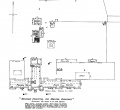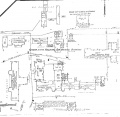Nevada State Asylum
| Nevada State Asylum | |
|---|---|
 | |
| Opened | 1882 |
| Current Status | Active |
| Building Style | Cottage Plan |
| Architect(s) | A. A. Cook |
| Location | Reno, NV |
| Architecture Style | Second-Empire Revival |
| Alternate Names |
|
Contents
History
The Nevada Insane Asylum opened its doors to 1481 Nevada citizens on July 1, 1882. The "poor unfortunates" arrived by train at 4:30 AM from Stockton, California, where they had been housed and cared for by Doctors Langdon and Clark at their Woodbridge asylum near Stockton. The patients were welcomed back to Nevada to a brand new facility, the pride of the State.
From the beginning, due to its great distance from Reno (three miles out of town and no Sparks until 1905) and in keeping with the times, the "Asylum" was a working farm and remained so through the 1960s. They grew alfalfa, fruit trees and vegetables, raised cattle, pigs, and chickens, and had a dairy. Irrigation was provided via ditches from the Truckee River and domestic water was pumped to a water tower on the grounds (see the wooden water tank on above roof in the photo). You can still find remnants of the irrigation ditches if you walk the grounds. Later, the river powered a generator for electricity for the site. Most of the product from the farm operation was used to feed the patients and staff, with occasional surplus being sold. Since the facility was principally self-sufficient, there were numerous support buildings as well, including barns, maintenance shops, a boiler plant, laundry, a morgue, and, of course, a cemetery.
The patients (called inmates at the time) came from all walks of life. The majority of the male population were farmers, laborers, and miners, and the females were mostly housewives. Patients who were able were given the opportunity to participate in the chores that kept the place running. The treatment practices of the day believed that restful circumstances and honest labor were instrumental in progress toward a cure for the "poor unfortunates." We have not uncovered evidence that patients were forced to work. Secondly, there were the staff members who were required to live on the premises. The Superintendent was a political appointee, in keeping with the times, and always a medical doctor. Other staff included a matron/nurse, attendants, cooks, and farmers.
Over the years, the Asylum suffered neglect by the Nevada Legislature. Beautiful as it was, the original building was poorly constructed and in constant need of repair. The Superintendents continually asked for funds from the legislature for improvements, but with Nevada's boom-and-bust economic cycles, most of the time nothing was done until desperate measures were needed. Adding to the repair problems was continual patient population growth. One reason for the population growth was the admission of "old, harmless, incurable, idiotic and imbecile patients" by the counties in which they lived in order to relieve the county of the expense of maintaining them. By 1895 the building, which had been designed to house 160 patients, contained 196. The legislature that year approved $15,000 to build and furnish an annex on the eastern end of the building to accommodate 75 additional patients.
Images
Main Image Gallery: Nevada State Asylum Image Gallery






